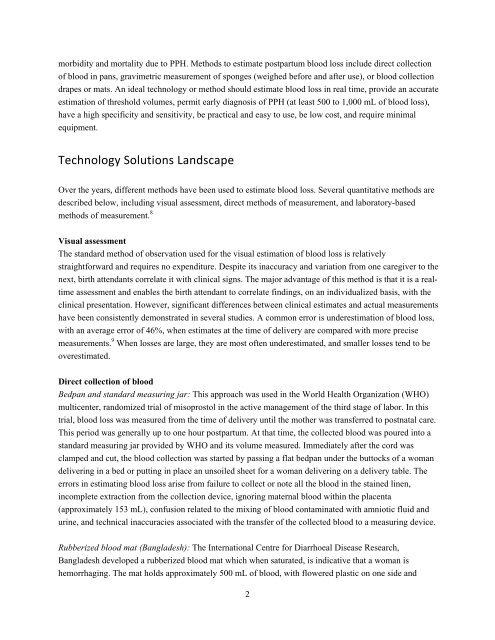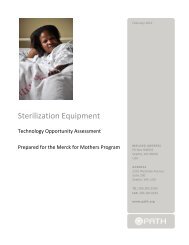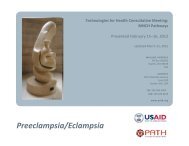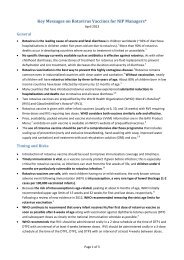Blood Loss Measurement - Path
Blood Loss Measurement - Path
Blood Loss Measurement - Path
Create successful ePaper yourself
Turn your PDF publications into a flip-book with our unique Google optimized e-Paper software.
morbidity and mortality due to PPH. Methods to estimate postpartum blood loss include direct collectionof blood in pans, gravimetric measurement of sponges (weighed before and after use), or blood collectiondrapes or mats. An ideal technology or method should estimate blood loss in real time, provide an accurateestimation of threshold volumes, permit early diagnosis of PPH (at least 500 to 1,000 mL of blood loss),have a high specificity and sensitivity, be practical and easy to use, be low cost, and require minimalequipment.Technology Solutions LandscapeOver the years, different methods have been used to estimate blood loss. Several quantitative methods aredescribed below, including visual assessment, direct methods of measurement, and laboratory-basedmethods of measurement. 8Visual assessmentThe standard method of observation used for the visual estimation of blood loss is relativelystraightforward and requires no expenditure. Despite its inaccuracy and variation from one caregiver to thenext, birth attendants correlate it with clinical signs. The major advantage of this method is that it is a realtimeassessment and enables the birth attendant to correlate findings, on an individualized basis, with theclinical presentation. However, significant differences between clinical estimates and actual measurementshave been consistently demonstrated in several studies. A common error is underestimation of blood loss,with an average error of 46%, when estimates at the time of delivery are compared with more precisemeasurements. 9 When losses are large, they are most often underestimated, and smaller losses tend to beoverestimated.Direct collection of bloodBedpan and standard measuring jar: This approach was used in the World Health Organization (WHO)multicenter, randomized trial of misoprostol in the active management of the third stage of labor. In thistrial, blood loss was measured from the time of delivery until the mother was transferred to postnatal care.This period was generally up to one hour postpartum. At that time, the collected blood was poured into astandard measuring jar provided by WHO and its volume measured. Immediately after the cord wasclamped and cut, the blood collection was started by passing a flat bedpan under the buttocks of a womandelivering in a bed or putting in place an unsoiled sheet for a woman delivering on a delivery table. Theerrors in estimating blood loss arise from failure to collect or note all the blood in the stained linen,incomplete extraction from the collection device, ignoring maternal blood within the placenta(approximately 153 mL), confusion related to the mixing of blood contaminated with amniotic fluid andurine, and technical inaccuracies associated with the transfer of the collected blood to a measuring device.Rubberized blood mat (Bangladesh): The International Centre for Diarrhoeal Disease Research,Bangladesh developed a rubberized blood mat which when saturated, is indicative that a woman ishemorrhaging. The mat holds approximately 500 mL of blood, with flowered plastic on one side and2










